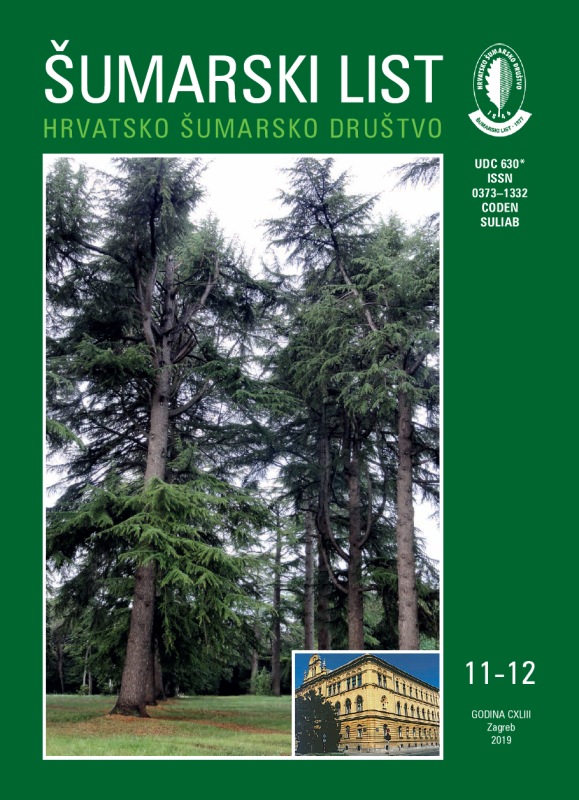
broj: 11-12/2019
pdf (10,71 MB) |
|
||||||||||||||
| RIJEČ UREDNIŠTVA | ||
| Uredništvo | ||
| Should the national forestry policy and strategy be modernized? pdf HR EN | 513 | |
| IZVORNI ZNANSTVENI ČLANCI | ||
| Jurij Marenče, Marijan Šušnjar | UDK 630* 375 (001) https://doi.org/10.31298/sl.143.11-12.1 | |
| Limiting forces and load masses during timber winching pdf HR EN | 515 | |
| Ivan Lukić, Željko Zgrablić, Vlatka Mičetić Stanković | UDK 630* 453 (001) https://doi.org/10.31298/sl.143.11-12.2 | |
| Presence of birch bark beetle (Scolytus ratzeburgi) in Croatia pdf HR EN | 523 | |
| Stjepan Kvesić, Dalibor Ballian, Mirzeta Memišević Hodžić | UDK 630* 164 (001) https://doi.org/10.31298/sl.143.11-12.3 | |
| Population variability of field maple (Acer campestre L.) in Bosnia and Herzegovina according to the fruit morphology pdf HR EN | 529 | |
| Deniz Güney, Zeki Yahyaoglu, Ali Bayraktar, Fahrettin Atar, Ibrahim Turna | UDK 630* 165 (001) https://doi.org/10.31298/sl.143.11-12.4 | |
| Genetic diversity of Picea orientalis (L.) Link populations in Turkey pdf HR EN | 539 | |
| PREGLEDNI ČLANCI | ||
| Ilija Đorđević, Nenad Ranković, Jelena Nedeljković, Jelena Tomićević-Dubljević, Dragan Nonić, Stjepan Posavec, Goran Češljar | UDK 630* 934 + 676 (001) https://doi.org/10-31298/sl.143.11-12.5 | |
| Mechanisms of financing the protected area management system in Serbia pdf HR EN | 549 | |
| PRETHODNO PRIOPĆENJE | ||
| Nikica Ogris, Tine Hauptman, Maarten de Groot, Dušan Jurc | UDK 630* 270 + 305 https://doi.org/10.31298/sl.143.11-12.6 | |
| Comparison of two methods for monitoring urban forests health pdf HR EN | 561 | |
| Ivan Pervan, Tena Radočaj, Tea Tomljanović, Miljenko Bujanić, Dean Konjević | UDK 630* 134 https://doi.org/10.31298/sl.143.11-12.7 | |
| Determination of sex and morphological characteristics of fat dormouse (Glis glis) from the area of Dalmatian hinterland pdf HR EN | 571 | |
| STRUČNI ČLANCI | ||
| Damir Drvodelić, Milan Oršanić | UDK 630* 232 https://doi.org/10.31298/sl.143.11-12.8 | |
| Selecting high quality forest seedlings of narrow-leaved ash (Fraxinus angustifolia Vahl) for regeneration and reforestation purposes pdf HR EN | 577 | |
| Summary This expert article describes in detail all the factors that affect the cultivation of quality forest seedlings of narrow-leaved ash for artificial regeneration and afforestation. So far no attention has been paid to the quality of the seedlings given the new and completely changed adverse ecological and biological factors occurring in narrow-leaved ash stands in Croatia. The quality of field ash seedlings was determined solely by one morphological factor, which is usually the shoot height, which is not good. The paper defines the concepts of morphological and physiological quality of seedlings. Methodologies for measuring the morphological and physiological characteristics of forest seedlings and their importance for survival, growth and growth after field planting are described. Morphological features include shoot height, stem diameter, height: diameter ratio, bud length, root and stem volume, weights, shoot: root ratio, and colour, form, and damage. Physiological properties are: cold hardiness, root growth potential (RGP), bud dormancy and foliar nutrient concentration. Three stress factors that affect the decrease in forest seedling quality, survival, growth, and field gains are described, namely: plant moisture stress (PMS), temperature stress, and physical stress (falling, crushing, vibration, surface damage, and root tearing).All other stress factors that affect the decline in the quality of forest seedlings, which occurs during the period from the nursery to field planting, have been identified. The role of an individual stress factor on seedlings is clarified, and so is the cumulative influence of multiple stress factors. The article deals with the correct handling of seedlings from harvesting in the nursery to afforestation. Recent patented protection options for seedlings from the time of removal from the nursery or cold storage truck to planting in the field are presented. Key words: morphological quality of forest seedlings; physiological quality of forest seedlings; stress factors in forest seedlings; seedling handling; seedling protection | ||


